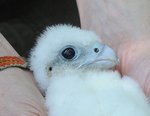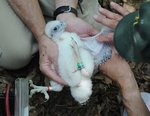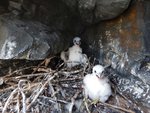 Narrowsburg
NarrowsburgLight Rain Fog/Mist, 43°
Wind: 8.1 mph
 Narrowsburg
NarrowsburgWhen we think of peregrine falcons nowadays, we think of them nesting on high building ledges and bridge superstructures in urban areas. Following their slow comeback after a drastic population …
Stay informed about your community and support local independent journalism.
Subscribe to The River Reporter today. click here
This item is available in full to subscribers.
Please log in to continue |



When we think of peregrine falcons nowadays, we think of them nesting on high building ledges and bridge superstructures in urban areas. Following their slow comeback after a drastic population decline in the mid-1900s due to the effects of DDT, breeding pairs of peregrine falcons have developed a fondness for tall man-made structures in urban areas. Historical cliff nesting areas went unused for the most part. As the population of peregrines increased, though, it was only a matter of time before some of these cliff sites started to get utilized.
On June 7, the National Park Service (NPS) sent out a press release from their Delaware Water Gap National Recreation Area; an excerpt is shown here:
“After a 70-year-long absence, peregrine falcons have successfully nested this year in the Milford Cliffs area of the Delaware Water Gap National Recreation Area. Historic nesting pairs were first reported on these cliffs in the 1940s and 1950s. No nests have been identified at this site until now.”
The pair was first observed in February of this year. NPS rangers and volunteers observed the area through the winter into the spring, and it was found that they had eggs. In late May, there were signs that at least one egg successfully hatched.
In June, a nest survey was organized between the PA Game Commission (PGC) and the NPS. Members of the NPS Technical Rescue Team rappelled down to the nest scrape on the cliff and retrieved the young (or eyases as young falcons are called) and raised them to the top of the cliff, where Art McMorris, a biologist heading up the peregrine program for the PGC, was waiting.
There were two young taken up the cliff, as well as an unhatched egg (probably unfertilized). The young were measured to determine sex and age (they were just short of three weeks old). They were checked for parasites and dusted for the same, and DNA samples were taken. Both eyases were in good health and they were fitted with leg bands. After processing, the young falcons were lowered back to the nest scrape. During the processing, the adult birds made their presence known, vocalizing and making close passes, but not contacting the climbers or the processing group on top of the cliff, tame behavior compared to the reception that some banding parties get.
A week later, both young were observed in the morning sun on the nest scrape, larger and showing more feathers rather than down. The adult male was perched on his favorite lookout 30 feet to the right of the young. It is hoped that, in a few weeks, they will both successfully fledge and become the first peregrines to successfully breed here in 70 years.
Comments
No comments on this item Please log in to comment by clicking here